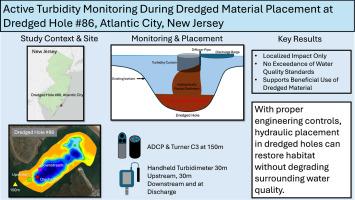Active turbidity monitoring during dredged material placement at dredged Hole #86, Atlantic City, New Jersey
Q2 Environmental Science
引用次数: 0
Abstract
This study presents findings from turbidity monitoring conducted during the open-water hydraulic placement of dredged material at Dredged Hole #86 (DH86), located in the back-bay waterways adjacent to Atlantic City, New Jersey. Turbidity, depth and current measurements were collected using in-situ and manual sensors. Results indicated that the hydraulic dredged material placement operations did not lead to observable increases in turbidity levels above background levels (prior to fill operations). This study demonstrated that placement of dredged material into a subaqueous pit resulted in elevated turbidity, however, the impact was temporary and localized and therefore does not pose a risk to the water quality in the area surrounding the discharge location. DH86 will continue to be a viable placement site for ongoing navigational channel dredging needs in this area, while at the same time providing needed habitat restoration in the back bays of New Jersey. The larger implication is that the project will increase acceptance of dredged material placement into dredged holes as a financially and environmentally responsible method for placement of dredged sediments to perform habitat restoration. There are over 100 dredged holes in New Jersey that can be a sediment sink for the New Jersey Marine Transportation System’s navigation channels.

主动浊度监测疏浚材料放置在86号疏浚洞,大西洋城,新泽西州
本研究展示了在疏浚洞#86 (DH86)进行疏浚材料开放水域水力放置期间进行的浊度监测的结果,该洞位于新泽西州大西洋城附近的后海湾水道。浊度,深度和电流测量数据收集使用原位和手动传感器。结果表明,水力疏浚材料放置作业没有导致浊度水平高于背景水平的明显增加(在填充作业之前)。这项研究表明,将疏浚的材料放入水下坑中会导致浑浊度升高,然而,这种影响是暂时的和局部的,因此不会对排放地点周围地区的水质构成风险。DH86将继续成为该地区正在进行的航道疏浚需求的可行安置地点,同时在新泽西州的后海湾提供所需的栖息地恢复。更大的影响是,该项目将增加人们对疏浚材料放入疏浚孔的接受度,作为一种经济和环保的方法来放置疏浚沉积物,以恢复生境。新泽西州有超过100个疏浚的洞,可以作为新泽西州海洋运输系统航道的沉淀池。
本文章由计算机程序翻译,如有差异,请以英文原文为准。
求助全文
约1分钟内获得全文
求助全文
来源期刊

Environmental Challenges
Environmental Science-Environmental Engineering
CiteScore
8.00
自引率
0.00%
发文量
249
审稿时长
8 weeks
 求助内容:
求助内容: 应助结果提醒方式:
应助结果提醒方式:


